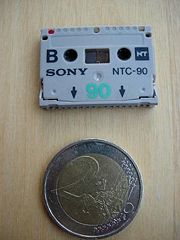.gif)
NT (cassette)
Encyclopedia

Sony
, commonly referred to as Sony, is a Japanese multinational conglomerate corporation headquartered in Minato, Tokyo, Japan and the world's fifth largest media conglomerate measured by revenues....
in 1992, sometimes marketed under the name Scoopman. The system stored memos using helical scan
Helical scan
Helical scan is a method of recording high bandwidth signals onto magnetic tape. It is used in reel-to-reel video tape recorders, video cassette recorders, digital audio tape recorders, and some computer tape drives....
ning on special microcassette
Microcassette
A Microcassette is an audio storage medium introduced by Olympus in 1969. It uses the same width of magnetic tape as the Compact Cassette but in a much smaller container. By using thinner tape and half or a quarter the tape speed, microcassettes can offer comparable recording time to the compact...
s, which were 30 × 21.5 × 5 mm with a tape width of 2.5 mm, with a recording capacity of up to 120 minutes. The Scoopmen media comes in three forms: The Sony NTC-60, -90, and -120, each describing the length of time (in minutes) the media could record.
NT stands for Non-Tracking, meaning the head moves at a shallower slope to that of the tracks on the tape, crossing several during each pass, albeit only reading partial data from each one. By making several different passes it is possible to reassemble the complete data for each track, in memory. This considerably reduced the complexity and size of the head, and therefore the recorder.
Another feature was Non-Loading, which meant instead of having a mechanism to pull the tape out of the cassette and wrap it around the drum, the drum was pushed inside the cassette to achieve the same effect.
Audio sampling was in stereo at 32 kHz/12 bit and encoded using a form of linear delta modulation
Delta modulation
Delta modulation is an analog-to-digital and digital-to-analog signal conversion technique used for transmission of voice information where quality is not of primary importance. DM is the simplest form of differential pulse-code modulation where the difference between successive samples is encoded...
called LDM-2.

